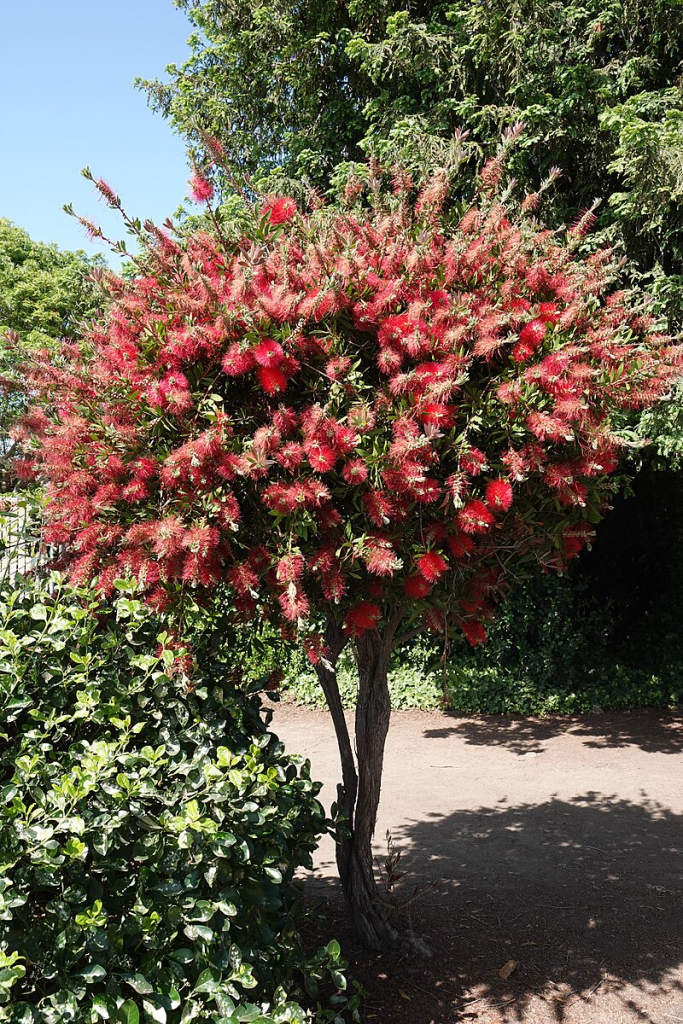
Native to Australia, these broadleaf evergreen shrubs or small trees are members of the myrtle family, Myrtaceae, that also includes clove, allspice, and eucalyptus. The common name, bottlebrush, comes from the resemblance of the inflorescence that to a bottle brush used to clean test tubes and bottles. The look is created by the large number of very long stamens tipped with yellow pollen that comprise the numerous flowers of each spike. The flowers have inconspicuous petals that fall off as the flowers mature and contribute little ornamental value to the flower. The flowers bloom from late spring to early summer and periodically throughout the year in warm climates. They contain a large quantity of nectar and are attractive to butterflies, bees, birds, including humming birds, and other pollinators. Each flower produces a small woody fruit containing hundreds of tiny seeds. These seed capsules form bunches along the stem and usually remain on the plant for many years.
In spite of the delicate look of the flowers, the plants are very tough. They have hard wood and long, thin, waxy leaves that usually dark green but sometimes colored and covered with fine soft hairs. They are often fragrant when bruised. The plants grow in a wide variety of soils except highly alkaline and are somewhat drought tolerant. Some tolerate both drought and periodic inundation. All like full sun for best flowering. Bottlebrush is low maintenance and needs only occasional tip pruning to maintain bushiness but can be cut to the ground if necessary. A spring and autumn application of low phosphorous fertilizer is appreciated. Plants are considered healthy with few pests or disease of significance. Propagation is by seed or semi hardwood cuttings and plants tolerate transplanting well.
Bottlebrush can be used for a hedge, screen, foundation planting and are an excellent choice for bird, hummingbird, butterfly, and pollinator gardens. Some species are good in containers and can be wintered indoors in cool climates.
The genus name, Callistemon, comes from the Greek words, κάλλος(kallis) meaning beautiful and στῆμα (stem) meaning stamen, referring to the dominant role of stamens in the the flowers. Photo Credit Sanjay Acharya, Wikimedia Commons
Crimson Bottlebrush (Callistemon citrinus aka Melaleuca citrina)

Plants grow up to 18′ tall and have lanceolate leaves that are 1-3″ long, have a lemony scent when crushed, and emerge coppery before turning medium green. In summer, or periodically during the growing season, terminal clusters of crimson flowers appear. The clusters are up to 4-5″ long and consist of up to 40 flowers with 35-40 prominent stamens. Crimson bottlebrush does well in a container. Photo Credit JJ Harison Wikimedia Commons
Height: 10-18′
Bloom Color: Crimson
Hardiness: Zones 9-10
Willow Bottlebrush (Callistemon salignus aka Melaleuca salicina)

Growing from a vigorous root system, plants can reach up to 50′ tall but in the garden usually grow 20-25′. New growth is pinky red while the papery bark is white or grey. The alternate, willow-like leaves are pendulous, 2-3″ long, and emerge pink to copper in color before turning dull green. The creamy white spikes of 10-40 flowers have 48-65 prominent stamens and are attractive to hummingbirds and butterflies. Photo Credit Wikipedia
Height: 20-25′
Bloom Color: Creamy-white
Hardiness: Zones 8-11
Alpine Bottlebrush (Callistemon sieberi aka Melaleuca pityoides)

Also known as marsh bottlebrush and river bottlebrush, alpine bottlebrush grows in and around sphagnum bogs and swamps and along watercourses, usually at altitudes between 3,000′ and 6500′. Plants grow up to about 3′ tall at high altitudes but to 10′ at lower altitudes, and tend to form dense thickets to the exclusion of other plants. The narrow leaves are .5-1″ long and sharply pointed. They are emerge pale silvery pink, are densely covered with silky hairs when young but turn dark green and loose most of the hairs on the underside with maturity. The dense terminal spikes of creamy yellow flowers, sometimes tinged with pink or green, are 2-4″ long, and have 10-15 flowers with 32-52 prominent stamens. Alpine bottlebrush is more tolerant of frost than most other bottlebrush species and is a very good choice for poor or wet soil.
Height: 3′ tall at high altitudes but to 10′ at lower altitudes
Bloom Color: Creamy yellow
Hardiness: Zones 7-11
Weeping Bottlebrush (Callistemon viminalis aka Melaleuca viminalis)

Also known as prickly bottlebrush, this bottlebrush grows 20-30′ tall and has fibrous furrowed bark and pendulous branches. The alternate leaves are 1-5″ long, light green, and narrowly elliptical to narrowly egg-shaped. The spikes of bright red flowers are 2-4″ long and have 15-50 flowers with 5 bundles of 9-14 prominent stamens Photo Credit Wikipedia
Height: 20-30′
Bloom Color: Bright red
Hardiness: Zones 9-11